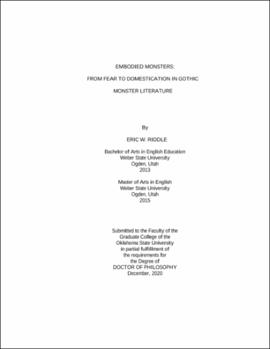| dc.contributor.advisor | Murphy, Tim | |
| dc.contributor.author | Riddle, Eric W. | |
| dc.date.accessioned | 2021-05-25T20:32:14Z | |
| dc.date.available | 2021-05-25T20:32:14Z | |
| dc.date.issued | 2020-12 | |
| dc.identifier.uri | https://hdl.handle.net/11244/329933 | |
| dc.description.abstract | This dissertation argues that over the course of the long nineteenth century, Gothic antagonists moved from supernatural but disembodied beings into more physically monstrous entities. The shift to monster follows traceable lines as the Gothic monster drifted from beings of terror to beings of horror. Directly related to the movement from terror to horror, we find that Gothic monsters become more physically present, and their bodies become sites of meaning and power. With an embodied self, the monster becomes capable of more physical harm. However, such a physical body brings with it a powerful negative characteristic. When protagonists encounter an embodied monster, they can impose meaning onto the monster. They can classify and apply pre-existing taxonomies onto the monster, rendering the monster knowable and, eventually, defeatable. | |
| dc.description.abstract | After defining key terms and foundational frameworks in the introduction, Chapter One explores the evolution of the monster in Gothic poetry from the eighteenth- and nineteenth-centuries. Chapter Two focuses more closely on a singular monster: the vampire. Tracing the literary history of the vampire from its Eastern European folkloric roots, through the nineteenth century, I explore how the vampire evolves through time to become more autonomous and powerful, but also more defeatable. The end of Chapter Two argues that once a monster loses some of its ability to inspire fear, society will begin to domesticate the monster until, as seen in Twilight or The Vampire Diaries, the monster becomes our romantic partner. Chapter Three builds off the previous two chapters, exploring how Robert Louis Stevenson's Strange Case of Dr. Jekyll and Mr. Hyde plays with the embodied monster in atypical ways. Then, the chapter moves on to explore how stage and screen adaptations of Stevenson's work represent the monster in a visual medium. | |
| dc.format | application/pdf | |
| dc.language | en_US | |
| dc.rights | Copyright is held by the author who has granted the Oklahoma State University Library the non-exclusive right to share this material in its institutional repository. Contact Digital Library Services at lib-dls@okstate.edu or 405-744-9161 for the permission policy on the use, reproduction or distribution of this material. | |
| dc.title | Embodied monsters: From fear to domestication in gothic monster literature | |
| dc.contributor.committeeMember | Wallen, Martin | |
| dc.contributor.committeeMember | Wilhelm, Lindsay | |
| dc.contributor.committeeMember | Igrek, Apple | |
| osu.filename | RIDDLE_okstate_0664D_16903.pdf | |
| osu.accesstype | Open Access | |
| dc.type.genre | Dissertation | |
| dc.type.material | Text | |
| dc.subject.keywords | domestication | |
| dc.subject.keywords | embodiment | |
| dc.subject.keywords | gothic | |
| dc.subject.keywords | monster | |
| thesis.degree.discipline | English | |
| thesis.degree.grantor | Oklahoma State University | |
